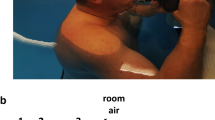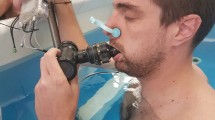Summary
Eight subjects performed maximum breath holds in air and naked head-out immersions of 2 min duration in stirred water at 5, 10 and 15° C. Analysis of the respiratory data collected in air and on immersion revealed a significant (P < 0.05) inverse relationship between the maximum breath hold time (t bh, max) of subjects in air and their frequency of breathing and inspiratory volumes on immersion. No such relationship was identified betweent bh, max in air and tidal volumes on immersion. It is concluded that thet bh, max of individuals in air may provide an indication of the magnitude of some of their respiratory responses to immersion. This information may be of use when personnel are being selected for activities with a high risk of immersion in cold water.
Similar content being viewed by others
References
Baker PT, Daniels F (1956) Relationship between skinfold thickness and body cooling for two hours at 15° C. J Appl Physiol 8:409–416
Cooper KE, Martin S, Riben P (1976) Respiratory and other responses in subjects immersed in cold water. J Appl Physiol 40:903–910
Godfrey S, Campbell EJM (1969) Mechanical and chemical control of breath holding. Q J Exp Physiol 54:117–128
Golden FStC, Tipton MJ (1987) Human thermal responses during leg-only exercise in cold water. J Physiol (Lond) 391:399–405
Golden FStC, Tipton MJ (1988) Human adaptation to repeated cold immersions. J Physiol (Lond) 396:349–363
Goode RC, Duffin J, Miller R, Romet TT, Chant W, Ackles A (1975) Sudden cold water immersion. Respir Physiol 23:301–310
Hayward JS, Eckerson JD, Collins ML (1977) Thermoregulatory heat production in man: prediction equation based on skin and core temperatures. J Appl Physiol 42:377–384
Hull EM, Young SH, Ziegler MG (1984) Aerobic fitness affects cardiovascular and catecholamine responses to stressors. Psychophysiology 21:353–360
Keatinge WR (1960) The effects of subcutaneous fat and of previous exposure to cold on the body temperature, peripheral blood flow and metabolic rate of men in cold water. J Physiol (Lond) 153:166–178
Keatinge WR (1978) Survival in cold water. Blackwell, Oxford
Keatinge WR, Evans M (1961) The respiratory and cardiovascular response to immersion in cold and warm water. Q J Exp Physiol 46:83–94
Keatinge WR, Nadel JA (1965) Immediate respiratory response to sudden cooling of the skin. J Appl Physiol 20:65–69
Keatinge WR, McIlroy MB, Goldfien A (1964) Cardiovascular responses to ice-cold showers. J Appl Physiol 19:1145–1150
McArdle WD, Katch FI, Katch VL (1981) Exercise physiology. Lea and Febiger, Philadelphia
Read DJCA (1967) A clinical method for assessing the ventilatory response to carbon dioxide. Aust Ann Med 16:20–32
RoSPA (1989) Drownings in the UK. Royal Society for the Prevention of Accidents, Cannon House, Birmingham, UK
Tikuisis P (1989) Prediction of the thermoregulatory response for clothed immersion in cold water. Eur J Appl Physiol 59:334–341
Tipton MJ (1989) The initial responses to cold water immersion in man. Clin Sci 77:581–588
Tipton MJ, Stubbs DA, Elliott DS (1991) Human initial responses to immersion in cold water at three temperatures and after hyperventilation. J Appl Physiol 70:317–322
World Health Organisation (1976) Biomedical research: a revised code of ethics. WHO Chron 30:360–362
Author information
Authors and Affiliations
Additional information
The author is from The Robens Institute, Surrey University, Guildford, UK
Rights and permissions
About this article
Cite this article
Tipton, M.J. The relationship between maximum breath hold time in air and the ventilatory responses to immersion in cold water. Europ. J. Appl. Physiol. 64, 426–429 (1992). https://doi.org/10.1007/BF00625061
Accepted:
Issue Date:
DOI: https://doi.org/10.1007/BF00625061




